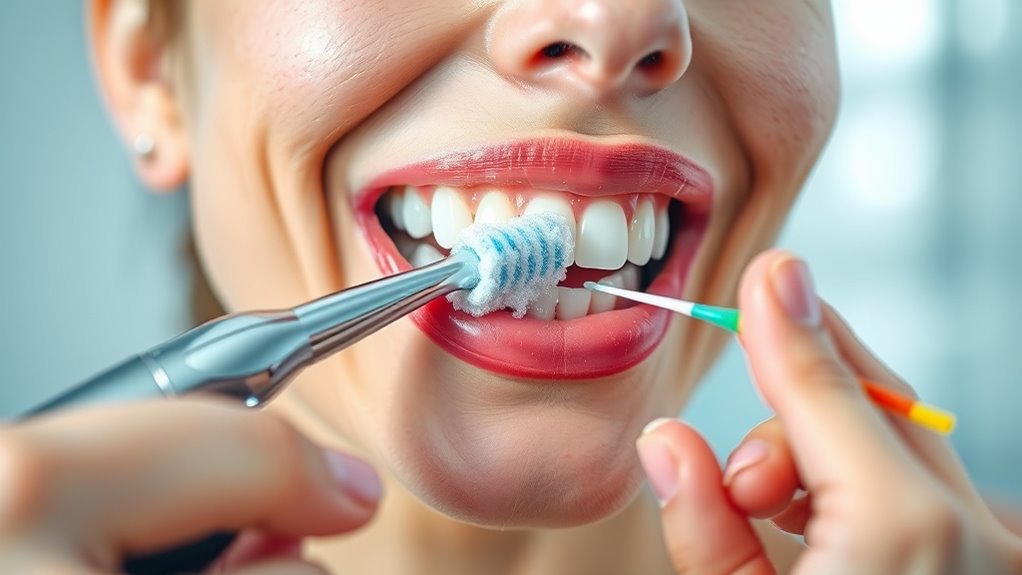To take good care of your teeth at home, use a soft-bristled toothbrush and fluoride toothpaste. Hold the brush at a 45-degree angle and use gentle circular motions for two minutes, twice daily. Floss carefully between teeth with about 18 inches of floss, curving it around each tooth gently. Avoid rushing or applying too much pressure, and stick with your routine daily—if you want to learn more, you’ll find helpful tips ahead.
Key Takeaways
- Hold your toothbrush at a 45-degree angle to gums and use gentle, circular motions for thorough cleaning.
- Brush all tooth surfaces, including outer, inner, and chewing areas, for at least two minutes twice daily.
- Floss about 18 inches, curving around each tooth in a C-shape, moving gently up and down beneath the gumline.
- Replace your toothbrush every 3-4 months and use fluoride toothpaste to prevent cavities and maintain oral health.
- Incorporate flossing and brushing into routines with specific times, reminders, and enjoyable tools to ensure consistency.
Choosing the Right Toothbrush and Toothpaste
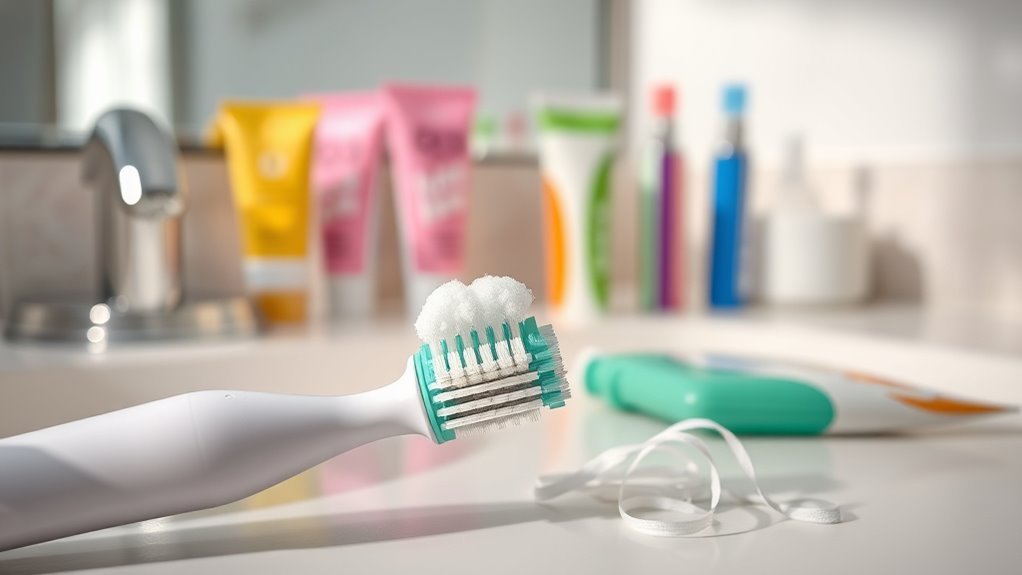
Choosing the right toothbrush and toothpaste is crucial for maintaining good oral health at home. When selecting a toothbrush, consider the toothbrush materials—look for soft bristles that gently clean your teeth without damaging gums. An ergonomic handle can make brushing more comfortable, especially for extended use. For toothpaste, pay attention to ingredients; fluoride is essential for cavity prevention, while abrasives help remove plaque. If you have sensitive teeth, opt for a toothpaste formulated for sensitivity. Avoid harsh ingredients that can irritate your mouth. Matching your toothbrush and toothpaste to your specific needs ensures effective cleaning and helps prevent dental issues. Regularly replacing your toothbrush every three to four months is also indispensable for maintaining ideal oral hygiene. Additionally, understanding dental care techniques can significantly improve your at-home oral hygiene routine.
Proper Brushing Technique for Effective Cleaning
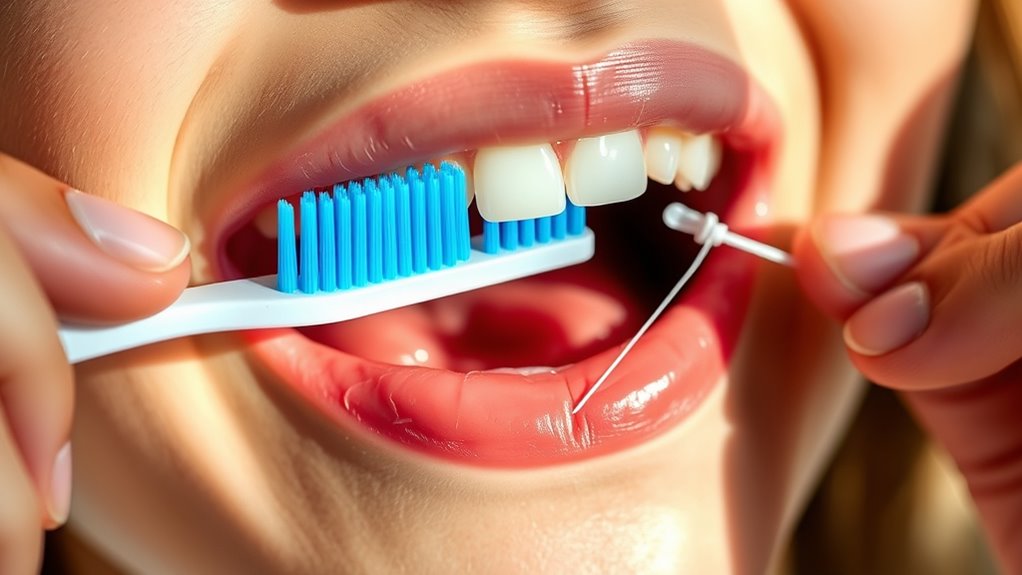
To guarantee your brushing is effective, it’s important to use the correct technique. Whether you prefer manual brushing or an electric toothbrush, proper form makes a difference. Hold your toothbrush at a 45-degree angle to your gums and use gentle, circular motions. Avoid aggressive scrubbing, which can damage gums and enamel. With manual brushing, ensure you cover all surfaces—outer, inner, and chewing surfaces—spending about two minutes in total. If you use an electric toothbrush, let the device do the work by guiding it slowly along each section of your mouth. Focus on thorough, gentle cleaning rather than speed. Consistent, proper technique helps remove plaque and prevents dental issues, keeping your mouth healthy and your smile bright. Additionally, choosing the right toothbrush with appropriate bristle firmness can enhance cleaning effectiveness and protect your gums. As the role of AI in healthcare grows, innovations like AI-powered dental tools are beginning to assist in routine dental care. Staying informed about dental health advances can further improve your at-home practices. Regularly practicing proper technique not only improves cleanliness but also supports overall oral health in the long term.
Timing and Frequency of Brushing
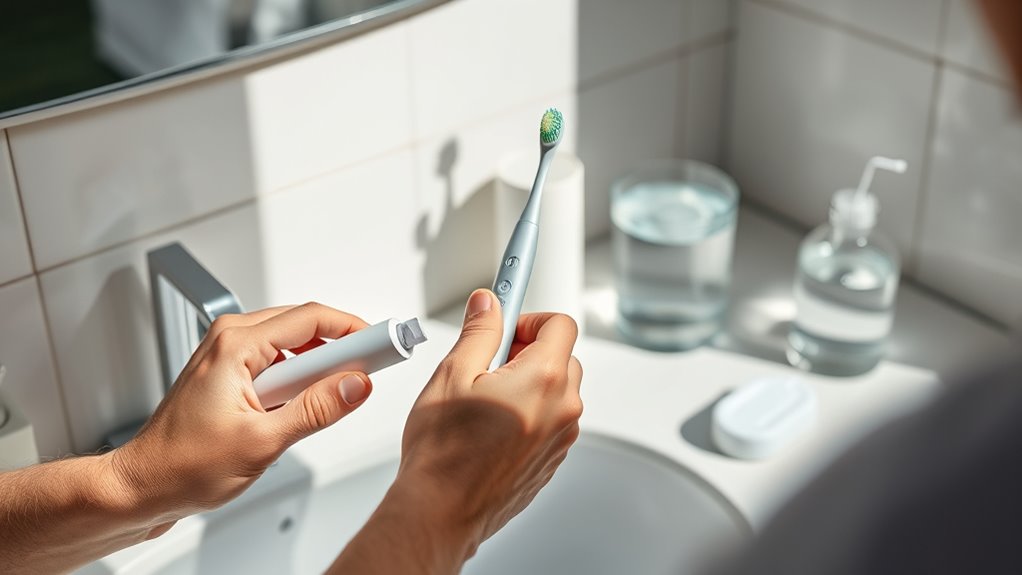
Brushing your teeth twice a day helps keep your mouth healthy and clean. Make sure you spend about two minutes each time to thoroughly remove plaque. For the best results, brush first thing in the morning and before bed, when your mouth is most vulnerable.
Twice Daily Brushing
Brushing your teeth twice a day is essential for maintaining good oral health, and doing so at consistent times helps prevent plaque buildup and cavities. Regular brushing keeps your oral hygiene in check and supports overall dental health. To make the most of your routine:
- Brush in the morning and before bed
- Use gentle circular motions
- Focus on all tooth surfaces
- Replace your toothbrush every three months
- Avoid eating or drinking right after brushing
- Incorporating proper technique ensures more effective cleaning and reduces enamel wear.
- Additionally, using a toothbrush with soft bristles can help prevent gum irritation and enamel erosion.
- Proper timing and technique also help protect the tooth enamel from unnecessary damage and wear.
- Following the recommended brushing duration of two minutes ensures thorough cleaning without damaging your teeth or gums.
- Being aware of dental health practices can further enhance your oral hygiene routine and prevent common dental issues.
Sticking to this twice-daily schedule ensures your teeth stay clean and healthy. Consistency is key to preventing issues like tartar and gum disease. Proper timing and frequency reinforce your oral hygiene habits, contributing notably to your long-term dental health.
Ideal Brushing Duration
While brushing your teeth twice a day is important, making certain you do so for the right amount of time is equally essential. The ideal brushing duration is about two minutes per session, which allows you to thoroughly clean all surfaces of your teeth. Pay attention to your brushing speed; a steady, gentle motion helps prevent aggressive pressure that can damage gums and enamel. Maintaining proper pressure control is vital—you want to remove plaque without causing harm. Avoid rushing through your routine, as a quick brush may leave plaque behind. Use a timer or an electric toothbrush with a built-in timer to stay on track. Consistently dedicating two minutes ensures you maximize cleaning effectiveness while protecting your oral health.
Timing for Best Results
To achieve the best oral health, you should brush your teeth at least twice a day, ideally once in the morning and once before bed. Timing is key to removing plaque and preventing decay. In your morning routine, brushing soon after waking helps kickstart oral hygiene and freshens your breath. In the evening, brushing before bed removes food particles and bacteria accumulated throughout the day, supporting your evening habits. Consider these tips: – Brush within 30 minutes of eating to prevent acid damage – Avoid rushing; spend at least two minutes each session – Don’t skip your night brushing, even if tired – Use fluoride toothpaste for added protection – Be consistent with your morning and evening routines for best results. Incorporating timely brushing routines can also help you stay motivated and consistent with your routine over time. Additionally, maintaining proper timing and frequency ensures you maximize the benefits of your oral hygiene efforts.
How to Floss Correctly for Optimal Results

Proper flossing is essential for removing plaque and debris between your teeth, but many people don’t do it correctly. To maximize benefits, focus on proper flossing techniques. Start with about 18 inches of floss, winding most of it around your middle fingers, leaving a few inches to work with. Gently slide the floss between your teeth, curving it into a C shape around each tooth and moving it up and down to clean beneath the gumline. Use fresh sections of floss as you go. Flossing tools like floss picks or interdental brushes can make the process easier, especially if you have limited dexterity. Consistent, gentle flossing removes plaque effectively and prevents gum disease, ensuring your mouth stays healthy. Incorporating proper technique into your routine enhances overall oral health and prevents the development of dental problems. Additionally, choosing the right type of floss based on your gum sensitivity can improve comfort and effectiveness during your routine. Being aware of dental care products can further optimize your oral hygiene practices and promote healthier teeth and gums.
Additional Tips for Maintaining Oral Hygiene
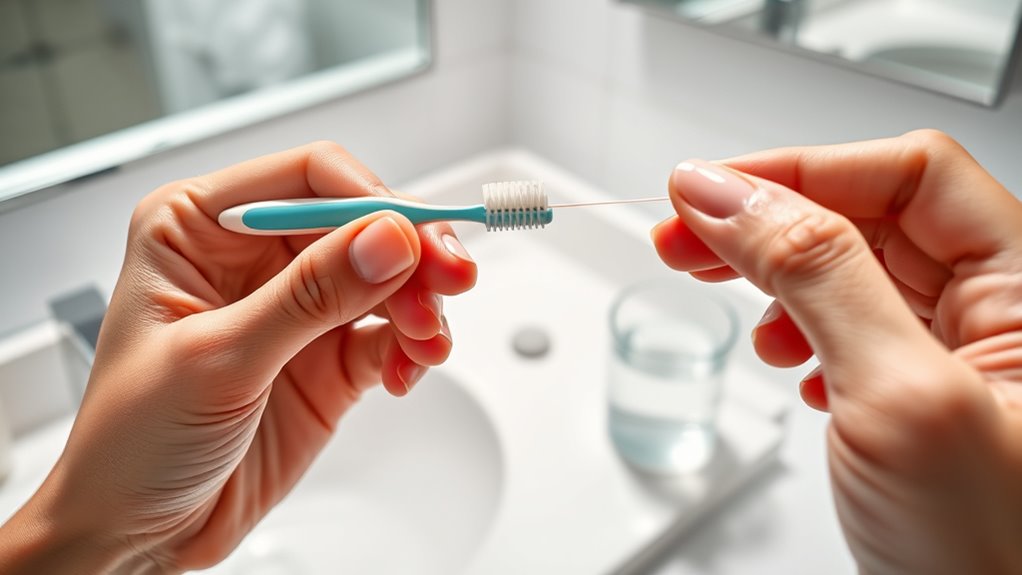
Maintaining good oral hygiene goes beyond just brushing and flossing regularly. To enhance your routine, consider the following tips. First, choose the right mouthwash by selecting one that targets your specific needs, like cavity prevention or freshening breath. Second, incorporate tongue cleaning techniques to remove bacteria and improve overall freshness. Third, stay hydrated to help rinse away food particles and maintain saliva production. Fourth, limit sugary foods and drinks that feed harmful bacteria. Fifth, schedule regular dental checkups for professional cleanings and advice. These extra steps support healthier teeth and gums, making your daily routine more effective. By paying attention to mouthwash selection and tongue cleaning, you’ll maintain a brighter smile and better oral hygiene overall. Additionally, understanding the importance of oral bacteria management can significantly contribute to long-term dental health.
Common Mistakes to Avoid During Brushing and Flossing

Even though brushing and flossing are essential for oral health, many people make simple mistakes that reduce their effectiveness. One common error is overbrushing, which can cause damage to your gums and enamel. Applying too much pressure wears down tooth surfaces and increases sensitivity. Additionally, an improper flossing technique can do more harm than good. If you don’t gently slide the floss between your teeth or miss areas, plaque remains and gums may bleed or become irritated. Rushing through these routines or using the wrong motions diminishes their benefits. To avoid these mistakes, use gentle, circular motions when brushing and a careful, gentle back-and-forth motion with floss. Proper technique guarantees thorough cleaning without damaging your gums or teeth. Incorporating gentle exfoliation methods can help maintain healthy skin around your mouth and prevent buildup that might interfere with oral hygiene routines. Recognizing the importance of professional dental check-ups can also help identify and correct any brushing or flossing issues before they lead to more serious problems.
Incorporating These Practices Into Your Daily Routine

To make good oral health habits stick, you need to incorporate brushing and flossing into your daily routine seamlessly. Habit formation happens through consistency, so integrating these practices at specific times makes them automatic. Establish clear triggers, like brushing right after breakfast or flossing before bed, to reinforce your routine. Keep supplies easily accessible to avoid excuses. Use reminders or habit trackers to stay accountable. Make it enjoyable by choosing your favorite toothbrush and flavored floss. Over time, these small adjustments become second nature, ensuring you maintain excellent oral health daily. Additionally, using proper techniques during brushing and flossing maximizes their effectiveness. Paying attention to technique details such as angle and pressure can significantly improve your oral health outcomes. Incorporating effective oral care into your routine can also help prevent issues like plaque buildup and gum disease. By prioritizing these habits, you create a solid foundation for long-term dental wellness without thinking twice. Remember, consistency is key to turning good intentions into lifelong habits.
Frequently Asked Questions
How Often Should I Replace My Toothbrush for Optimal Oral Health?
You should replace your toothbrush every three to four months, as this guarantees ideal oral health. Over time, the toothbrush’s bristle wear decreases cleaning effectiveness, reducing its ability to remove plaque and debris. A worn-out toothbrush’s lifespan is limited, and using an old one can introduce bacteria. Keep an eye on bristle wear, and switch your toothbrush promptly to maintain proper oral hygiene and prevent dental issues.
Can Electric Toothbrushes Improve My Cleaning Compared to Manual Ones?
Electric toothbrushes can markedly improve your cleaning efficiency compared to manual ones. They often have oscillating or sonic technology that helps remove plaque more effectively and reach difficult spots. If you’re looking for a way to enhance your oral hygiene routine, switching to an electric toothbrush could be a smart move. Just make sure to choose one with the right features and replace the brush head regularly for the best results.
Is It Necessary to Use Mouthwash Along With Brushing and Flossing?
You might wonder if using mouthwash along with brushing and flossing is necessary. Mouthwash benefits include freshening your breath and reducing bacteria, which can boost your oral health. However, mouthwash risks involve potential irritation or alcohol content that can dry your mouth. While not essential, using an antiseptic or fluoride mouthwash can enhance your routine, but always choose one suited to your needs and consult your dentist if unsure.
What Are Signs That My Brushing Technique Needs Improvement?
If your gums bleed when you brush or notice persistent plaque buildup, your brushing technique might need improvement. Bleeding gums can indicate you’re missing spots or brushing too hard, while plaque buildup shows you’re not cleaning effectively. Pay attention to these signs and adjust your brushing to gentle, circular motions, ensuring you cover all areas. Regularly reviewing your technique helps maintain healthy gums and prevent dental issues.
How Does Diet Impact My Oral Hygiene Routine?
Think of your diet as the foundation of your oral health; it’s the old saying, “You are what you eat.” High sugar intake and acidic foods can erode enamel and promote cavities. Cutting back on sugary snacks and limiting acidic drinks helps protect your teeth, making your brushing and flossing routines more effective. A balanced diet keeps your smile strong, reducing the risk of decay and gum problems.
Conclusion
So, you’ve got the perfect brushing and flossing routine—great! Just remember, even with all your efforts, plaque might still throw a party in your mouth. But hey, at least you’re doing your best, right? Keep up the good work, stay consistent, and maybe, just maybe, you’ll outsmart those sneaky cavities. After all, who knew fighting tooth decay could be so simple… or so ironically rewarding?

